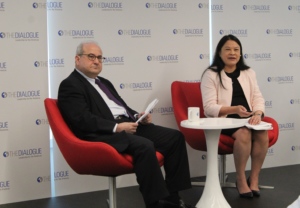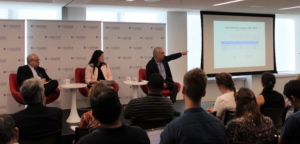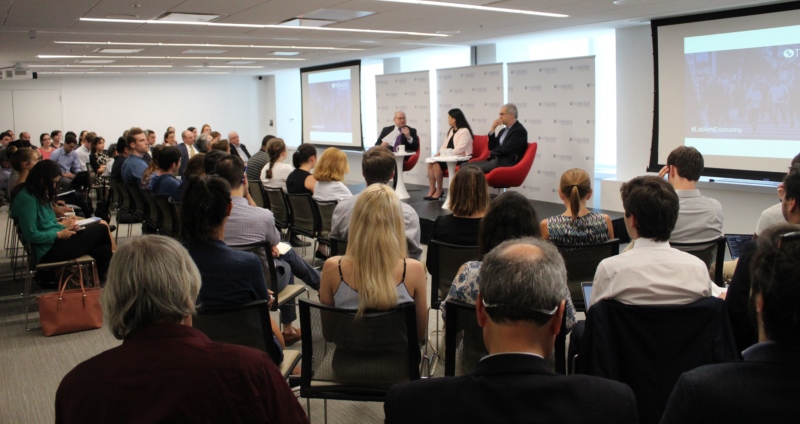
How Is Latin America’s Middle Class Faring?
Why has growth of the region’s middle class slowed down? What needs to be done to maintain the gains of the last decade?
On July 22, the Inter-American Dialogue hosted the event “Confronting Latin America’s Economic Challenges: What Can the Region Do?” with Joyce Chang, the Chair of Global Research at JP Morgan, and Santiago Levy, a nonresident fellow with the Global Economy and Development Program at Brookings and president of the Latin American and Caribbean Economic Association. The Inter American Dialogue’s president Michael Shifter delivered opening remarks and moderated this session.
Both speakers discussed the stagnant economic growth in Latin America, comparing a variety of domestic and external factors that attest to the current state of the economy in the region, addressing the situation in different countries, mostly the largest economies in the region -Brazil, Argentina, Mexico and Colombia. While both speakers focused on distinct aspects affecting the economy, each of their commentaries consisted of an effort to explain the current economic stagnation in Latin America.
[caption id="attachment_85429" align="alignleft" width="270"] Joyce Chang[/caption]
Joyce Chang[/caption]
Joyce Chang opened by addressing the question, “Why has growth slowed down so much in the region?” She argued that it is due to a mix of global and domestic factors, such as internal economic structures, China, trade uncertainty and commodity dependency. Chang pointed out that when analyzing the situation, the focal point cannot simply be around Argentina and Venezuela; more economies need to be included when analyzing the region’s outlook. Chang shared several indicators that factored into JP Morgan’s analysis process, including various metrics showing how Latin America remains behind all other regions in terms of productivity. Chang noted that current observations follow regional trends present for the past few years, stating that this is the 6th straight year in which the region is growing below potential. She also emphasized that, although JP Morgan estimates 2% growth in the region for next year, they also had estimated 2% growth for 2019 last year, a figure which the region has fallen short of. Given current conditions, Chang wondered if the region is currently at the bottom of its period of stagnation, with more growth and productivity to come.
[caption id="attachment_85432" align="alignright" width="300"] Santiago Levy[/caption]
Santiago Levy[/caption]
Santiago Levy’s commentary thoroughly analyzed the economic, social and political structures within various Latin American nations. He emphasized that, in simple accounting terms, GDP growth is a sum of growth in capital, productivity, and labor, so growth in the region can be analyzed under these criteria. He focused on the productivity portion of the equation, sharing the saddening reality that Latin America has had no net productivity growth in the past half-century. This zero-net productivity growth means that, despite regional gains in capital and labor that surpass developed nations, Latin America has not caught up but, rather, has fallen farther behind. He pointed out that the lack of productivity can no longer be attributed to macro crises and the external environment but is instead due to domestic factors such as inefficient labor markets which he called “dysfunctional social arrangements.” He highlighted some of the principal factors that feed into these dysfunctional social arrangements, such as how most people in the region work informally, how legal structures prevent the market from forcing growth and innovation, allowing inefficient firms to flourish, and how labor markets and industries are extremely concentrated. Levy also pointed out that although it is essential to be aware of the external factors affecting the economy, there is no way to avoid the domestic change that needs to happen to drive growth. After all, all emerging markets have historically faced the same external factors, and almost all others have managed better than Latin America.
The panel ended with a Q&A that further explored some of the points raised by the panelists and continued the analysis by looking at individual nations as case studies for what has gone wrong and what has gone right in the region. Additionally, some questions added historical context to the discussion, such as the fact that growth is a relatively new phenomenon and that regulations for labor markets have not changed much since the first half of the 20th century.
Why has growth of the region’s middle class slowed down? What needs to be done to maintain the gains of the last decade?
Latin Americans should pay close and cautious attention to the Brexit. They are not immune to the fallout.
 Irene Estefania Gonzalez / Inter-American Dialogue
Irene Estefania Gonzalez / Inter-American Dialogue
